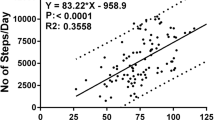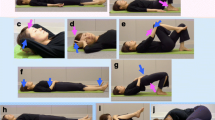Abstract
Purpose
This pilot pre-and post-intervention study investigated the effects of a short-term aquatic exercise programme on physiological outcomes, symptoms and exercise capacity in women with chronic fatigue syndrome/myalgic encephalomyelitis (CFS/ME).
Methods
Eleven women (54.8 ± 12.4 year) volunteered for the 5-week program; an initial 20-min aquatic exercise session then two self-paced 20-min sessions per week for 4 weeks. Pre- and post-intervention outcomes were physiological measures, 6 min Walk Test (6MWT), perceived exertion (RPE), hand grip strength, Sit-to-Stand, Sit-Reach test, Apley’s shoulder test, FACIT questionnaire, and 24-h post-test tiredness and pain scores (0–10 visual analogue scale). Heart rates, RPE, 24- and 48-h post-session tiredness/pain scores were recorded each session.
Results
6MWT distance increased by 60.8 m (p = 0.006), left hand grip strength by 6 kg (p = 0.038), Sit-Reach test by 4.0 cm (p = 0.017), right shoulder flexibility by 2.9 cm (p = 0.026), FACIT scores by 8.2 (p = 0.041); 24-h post-test tiredness and pain decreased by 1.5 and 1.6, respectively (p = 0.002). There were significant post-intervention increases in exercising heart rates (6MWT 4- and 6-min time points), oxygen saturation at 2-min, and reduced RPE at 4-min. Weekly resting and exercising heart rates increased significantly during the study but RPE decreased; immediately post- and 24-h post-session tiredness decreased significantly. There were no reports of symptom exacerbation.
Conclusions
Five weeks of low-moderate intensity aquatic exercise significantly improved exercise capacity, RPE and fatigue. This exercise mode exercise may potentially be a manageable and safe physical activity for CFS/ME patients.




Similar content being viewed by others
Abbreviations
- ANOVA:
-
Analysis of variance
- BPM:
-
Beats per minute
- CFS:
-
Chronic fatigue syndrome
- COPD:
-
Chronic obstructive pulmonary disease
- ES:
-
Effect size
- FACIT:
-
Functional assessment of chronic illness therapy-fatigue
- FMS:
-
Fibromyalgia syndrome
- HR:
-
Heart rate
- ME:
-
Myalgic encephalomyelitis
- MS:
-
Multiple sclerosis
- PEM:
-
Post-exertional malaise
- POTS:
-
Postural orthostatic tachycardia syndrome
- ROM:
-
Range of motion
- RPE:
-
Rate of perceived exertion
- SD:
-
Standard deviation
- 6MWT:
-
6-min walk test
- SNS:
-
Sympathetic nervous system
- SPSS:
-
Statistical package for the social sciences
- TSD:
-
Time since diagnosis
- TSSO:
-
Time since symptom onset
- VAS:
-
Visual analogue scale
References
Adamowicz J, Caikauskaite I, Friedberg F (2014) Defining recovery in chronic fatigue syndrome: a critical review. Qual Life Res 23(9):2407–2416
Andersen M, Permin H, Albrecht F (2004) Illness and disability in Danish chronic fatigue syndrome patients at diagnosis and 5-year follow-up. J Psychosom Res 56(2):217–229
Assis M et al (2006) A randomized controlled trial of deep water running: clinical effectiveness of aquatic exercise to treat fibromyalgia. Arthritis Rheum 55:57–65. https://doi.org/10.1002/art.21693
Baena-Beato P, Artero EG, Arroyo-Morales M, Robles-Fuentes A, Gatto-Cardia MC, Delgado-Fernández M (2014) Aquatic therapy improves pain, disability, quality of life, body composition and fitness in sedentary adults with chronic low back pain. Controll Clin Trial Clin Rehabilit 28:350–360
Batterham A, Hopkins W (2006) Making meaningful inferences about magnitudes. Int J Sports Physiol Perform 1:50–57
Becker B (2009) Aquatic therapy: scientific foundations and clinical rehabilitation applications. Phys Med Rehabilit 1:859–872. https://doi.org/10.1016/j.pmrj.2009.05.017
Benarroch E (2012) Postural tachycardia syndrome: a heterogeneous and multifactorial disorder. Mayo Clin Proc 87:1214–1225
Bento P, Rodacki A (2015) Muscle function in aged women in response to a water-based exercises program and progressive resistance training. Geriatr Gerontol Int 15:1193–1200
Bergamin M, Ermolao A, Tolomio S, Berton L, Sergi G, Zaccaria M (2013) Warer-versus land-based exercise in elderly subjects: effects on physical performance and body composition. Clin Interv Aging 8:1109–1117
Bidonde J et al (2014) Aquatic exercise training for fibromyalgia (review). Cochrane Database Syst Rev. https://doi.org/10.1002/14651858.CD011336
Bocalini D, Serra A, Murad N, Levy R (2008) Water- versus land-based exercise effects on physical fitness in older women. Geriatr Gerontol Int 8:265–271
Borg E (1982) Psychophysical bases of perceived exertion. Med Sci Sports Exerc 14:377–381
Brass J, Federoff L (2007) Psychological benefits of water aerobics for fibromyalgia patients. Int J Aquat Res Educ 1:255–268
Busch A et al (2011) Exercise therapy for fibromyalgia Curr. Pain Headaches Rep 15:358–367. https://doi.org/10.1007/s11916-011-0214-2
Carruthers B et al (2011) Myalgic encephalomyelitis: international consensus criteria. J Intern Med 270:327–338. https://doi.org/10.1111/j.1365-2796.2011.02428.x
Castro-Sanchez A, Mataran-Penarrocha G, Lara-Palomo I, Saavedra-Hernandez M, Arroyo-Morales M, Moreno-Lorenzo C (2012) Hydrotherapy for the treatment of pain in people with multiple sclerosis: a randomized controlled trial. Evid Based Complement Altern Med. https://doi.org/10.1155/2012/473963
Cella D (1997) Manual of the functional assessment of chronic illness therapy (FACIT) measurement system. Center on outcomes, research and education (CORE). Evanston Northwestern Healthcare and Northwestern University, Evanston
Cook D, Nagelkirk P, Poluri A, Mores J, Natelson B (2006) The influence of aerobic fitness and fibromyalgia on cardiorespiratory and perceptual responses to exercise in patients with chronic fatigue syndrome. Arthritis Rheum 54:3351–3362. https://doi.org/10.1002/art.22124
ESSA (2011) Adult pre-exercise screening tool Version 1. Exercise and Sports Science Australia
Fukuda K, Straus SE, Hickie I, Sharpe MC, Dobbins JG, Komaroff A (1994) The chronic fatigue syndrome: a comprehensive approach to its definition and study. Int Chronic Fatigue Syndr Study Group Ann Intern Med 121:953–959
Gabrielsen A, Videbaek R, Johansen L, Warberg J, Christensen N, Pump B, Norsk P (2000) Forearm vascular and neuroendocrine responses to graded water immersion in humans. Acta Physiol Scanda 169:87–94
Gordon B, Lubitz L (2009) Promising outcomes of an adolescent chronic fatigue syndrome inpatient programme. J Paediatr Child Health 45:286–290
Gordon B, Knapman L, Lubitz L (2010) Graduated exercise training and progressive resistance training in adolescents with chronic fatigue syndrome: a randomized controlled pilot study. Clin Rehabilit 24:1072–1079. https://doi.org/10.1177/0269215510371429
Gusi N, Tomas-Carus P, Hakkinen A, Hakkinen K, Ortega-Alonso A (2006) Exercise in waist-high warm water decreases pain and improves health-related quality of life and strength in the lower extremities in women with fibromyalgia. Arthritis Rheum 55(1):66–73
Hoad A, Spickett G, Elliot J, Newton J (2008) Postural orthostatic tachycardia syndrome is an under-recognized condition in chronic fatigue syndrome. Q J Med 101:961–965
Honda T, Kamioka H (2012) Curative and health enhancement effects of aquatic exercise: evidence based on interventional studies. Open Access J Sports Med 3:27–34
IOM (Institute of Medicine) (2015) Beyond myalgic encephalomyelitis/chronic fatigue syndrome: redefining an illness. The National Academics Press, Washington, DC
Jentoft E, Kvalvik A, Mengshoel A (2001) Effects of pool-based and land-based aerobic exercise on women with fibromyalgia/chronic widespread muscle pain. Arthritis Care Res 45:42–47
Kanitz A et al (2015) Effects of two deep water training programs on cardiorespiratory and muscular strength responses in older adults. Exp Gerontol 64:55–61. https://doi.org/10.1016/j.exger.2015.02.013
Kieffer HS, Lehman M, Veacock D, Korkuch L (2012) The effects of a short-term novel aquatic exercise program on functional strngth and performance of older adults. Int J Exerc Sci 5:321–333
Larun L, Brurberg KG, Odgaard-Jensen J, Price JR (2017) Exercise therapy for chronic fatigue syndrome. Cochrane Database Systematic Rev https://doi.org/10.1002/14651858.CD003200.pub7
Macias-Hernandez S, Vazquez-Torres L, Morones-Alba J, Coronado-Zarco R, Soria-Bastida M, Cruz-Medina E, Nava-Bringas T (2015) Water-based Tai Chi: theoretical benefits in musculoskeletal diseases. Current evidence. J Exerc Rehablit 11:120–124
Mannerkorpi K, Nordeman L, Ericsson A, Arndorw M, GAU study group (2009) Pool exercise for patients with fibromyalgia or chronic widespread pain: a randomized controlled trial and subgroup analyses. J Rehabilt Med 41:751–760
Massy-Westropp NM, Gill TK, Taylor AW, Bohannon RW, Hill CL (2011) Hand grip strength: age and gender stratified normative data in a population-based study. BMC Res Notes 4:127
McManimen S, Jason L (2017) Post-exertional malaise in patients with ME and CFS with comorbid fibromyalgia SLR. Neurol Neurosurg 3:22–27
McNamara R, McKeough Z, McKenzie D, Alison J (2015) Acceptability of the aquatic environment for exercise training by people with chronic obstructive pulmonary disease with physical comorbidities: additional results from a randomised controlled trial. Physiotherapy 101:187–192. https://doi.org/10.1016/j.physio.2014.09.002
Meredith-Jones K, Waters D, Legge M, Jones L (2011) Upright water-based exercise to improve cardiovascular and metabolic health: a qualitative review. Complement Ther Med 19:93–103. https://doi.org/10.1016/j.ctim.2011.02.002
Moss-Morris R, Sharon C, Tobin R, Baldi J (2005) A randomized controlled graded exercise trial for chronic fatigue syndrome: outcomes and mechanisms of change. J Health Psychol 10:245–259. https://doi.org/10.1177/1359105305049774
Plecash A, Leavitt B (2014) Aquatherapy for neurodegenerative disorders. J Huntingdon’s Dis 3:5–11. https://doi.org/10.3233/JHD-140010
Salem Y, Scott A, Karpatkin H, Concert G, Haller L, Kaminsky E, Weisbrot R, Spatz E (2011) Community-based aquatic programme for individuals with multiple sclerosis: a pilot study. Disabil Rehabil 33(9):720–728
Stormorken E, Jason L, Kirkevold M (2017) From good health to illness with postinfectious fatigue syndrome: a qualitative study of adults’ experiences of the illness trajectory. BMC Fam Pract 18:49–64
Taylor R, Kielhofner G (2005) Work-related impairment and employment-focused rehabilitation options for individuals with chronic fatigue syndrome: a review. J Ment Health 14(3):253–267
Torres-Ronda L, del Alcazar X (2014) The properties of water and their application for training. J Hum Kinet 44:237–248
Verhagen A, Cardoso J, Biema-Zeinstra S (2012) Aquatic exercise and balneotherapy in musculoskeletal conditions. Best Pract Res Clin Rheumatol 26:335–343
Wallman K, Morton A, Goodman C, Grove R, Guilfoyle A (2004) Randomised controlled trial of graded exercise in chronic fatigue syndrome. Med J Aust 180:444–448
Webster K, Cella D, Yost K (2003) The functional assessment of chronic illness therapy (FACIT) measurement system: properties, applications, and interpretation. Health Qual Life Outcomes 1:1–7
Wilson B, Spencer H, Kortebeine P (2012) Exercise recommendations in patients with newly diagnosed fibromyalgia. Phys Med Rehabilit 4:252–255. https://doi.org/10.1016/j.pmrj.2011.11.012
Acknowledgements
The authors acknowledge that this study was supported in part by an internal seed grant from Southern Cross University.
Author information
Authors and Affiliations
Contributions
SC and SB conceived and designed the research. All authors conducted data collection. SB analysed the data and created the tables. SC created the figures. All authors developed, read and approved the final manuscript.
Corresponding author
Ethics declarations
Conflict of interest
The authors declare that they have no conflict of interest.
Ethical approval
All procedures performed in studies involving human participants were in accordance with the ethical standards of the institutional and/or national research committee and with the 1964 Helsinki declaration and its later amendments or comparable ethical standards.
Data availability
The datasets generated during and/or analysed during the current study are available from the corresponding author on reasonable request.
Additional information
Communicated by Fabio Fischetti.
Rights and permissions
About this article
Cite this article
Broadbent, S., Coetzee, S. & Beavers, R. Effects of a short-term aquatic exercise intervention on symptoms and exercise capacity in individuals with chronic fatigue syndrome/myalgic encephalomyelitis: a pilot study. Eur J Appl Physiol 118, 1801–1810 (2018). https://doi.org/10.1007/s00421-018-3913-0
Received:
Accepted:
Published:
Issue Date:
DOI: https://doi.org/10.1007/s00421-018-3913-0




